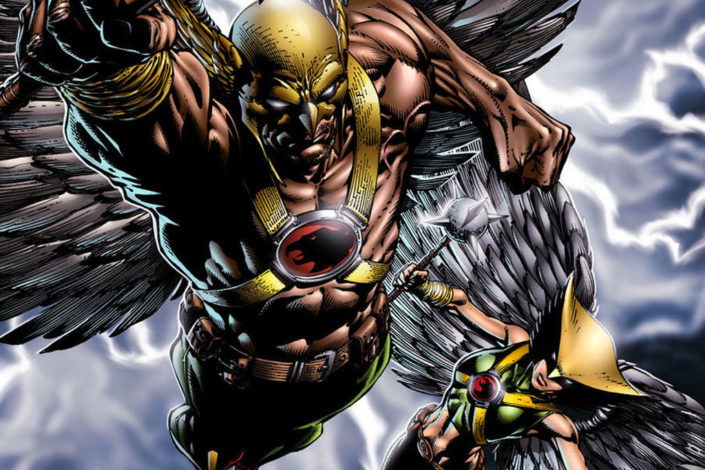
There is more than one DC Comics superhero named Hawkman. Created by writer Gardner Fox–who was apparently inspired by the sight of a bird while trying to come up with new superheroes–and Dennis Neville in Flash Comics #1 (January 1940) during the Golden Age of comic books, the first of the several incarnations of Hawkman was Carter Hall, a reincarnation of the ancient Egyptian prince Khufu.
Hall had discovered the “ninth metal” (aka “Nth metal”) that allow him to fly by negating the effects of gravity. He put on a costume and started to fight crime. He soon became a founding member of the Justice Society of America–and even became the chairman of the team. Also at that time, he started romancing Shiera Saunders, the reincarnated bride of Khufu, who became known as Hawkgirl.
Like most of the superheroes of the Golden Age, Hawkman disappeared for a while during the 1950s and was reinvented for the Silver Age under the guidance of famed DC editor Julius Schwartz. Revived in The Brave and the Bold # 34 (Feb–Mar 1961), his powers were quite similar but Hawkman was this time a police officer from the planet Thanagar–not a human anymore! Named Katar Hol he came to Earth with his wife Shayera in search of a criminal and stayed–the couple adopted secret identities, becoming Carter and Shiera Hall who worked at a museum in Midway City.
This time again, he joined the main DC Team, the Justice League of America, and met the original Hawkman during crossovers with the JSA from Earth-Two.
Like the rest of the DC Universe, the 1985 Crisis on Infinite Earths changed a lot for Hawkman and Hawkwoman. Everything became quite confusing until the 1989 Hawkworld series rebooted the Hawkman story. This time, Katar Hol and his partner Shayera were sent to Earth after rebelling against the Thanagarian government whose policy was predatory against other worlds.
Their arrival on Earth forced a retcon of the Golden Age Hawkman and Hawkgirl, as they were still alive and well. It was then revealed that the Nth metal was in reality from Thanagar. Also, we learned that it was really Fel Andar, a Thanagarian agent, who was the 1980s Hawkman who previously joined the JLA in order to spy on the heroes. All these corrections didn’t simplify the Hawk mythology as new events added complications to the point that DC decided to put the Hawks aside for a while.
It was in the 1990s, in the JSA series, that the continuity was revised. We then learned that Carter Hall and Shiera who got their powers from Thanagarian Nth metal had been reincarnated multiple times since ancient Egypt. Katar Hol come to Earth during the 1990s and Fel Andar returned to Thanagar. The reincarnation angle was used to launch a new Hawkman series in 2002.
All of this is the simple version, things were even more complicated in the books…
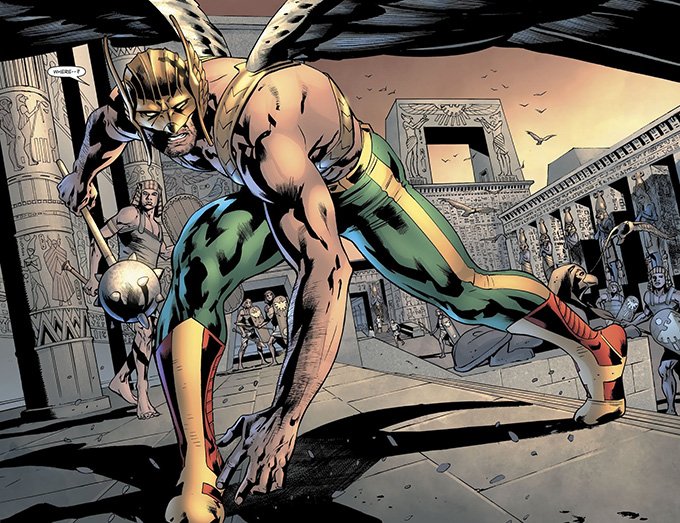
Where to start reading Hawkman?
The Hawkman mythology is a mess. DC Comics retconned the character multiple times, trying with each new approach to connect everything that came before with the new Hawkman–occasionally, the writers just forget some previous incarnations because they made no sense. As a result, Hawkman didn’t become excessively popular. It’s hard to stay invested in a character that is regularly rebooted.
If you want to start with Hawkman, began near the end with Robert Venditti’s Rebirth series. The writer offered an explication for Carter Hall/Katar Hol/and other incarnations that make sense, plus some good adventures. And it’s overall well done.
- Hawkman: Awakening
Collects Hawkman #1-6.
You can also read the classic Hawkworld miniseries by Tim Truman that introduced Wingman cop Katar Hol:
- Hawkworld: New Edition
Collects Hawkworld #1-3.
If you are into Geoff Johns’ JSA, his Hawkman series goes with it–and there’s a lot of Hawkgirl in it if you like the character.
- Hawkman by Geoff Johns Book One
Hawkman #1-14 and Hawkman: Secret Files and Origins #1.
For those interested, Kendra Saunders as Hawkgirl also has her own reading order!

Hawkman Reading Order
Hawkman during the Golden Age
Everything started for Carter Hall with Flash Comics #1, but also with All-Star Comics #3 (Winter 1940) when Hawkman joined the JSA. All those stories will be considered as part of the Eath-Two Universe during the Silver Age era.
- Golden Age Hawkman Archives
Collects select stories from Flash Comics #1-22. - Hawkman was in all of the JSA issues of the Golden Age, go to our Justice Society of America Reading Order for more information.
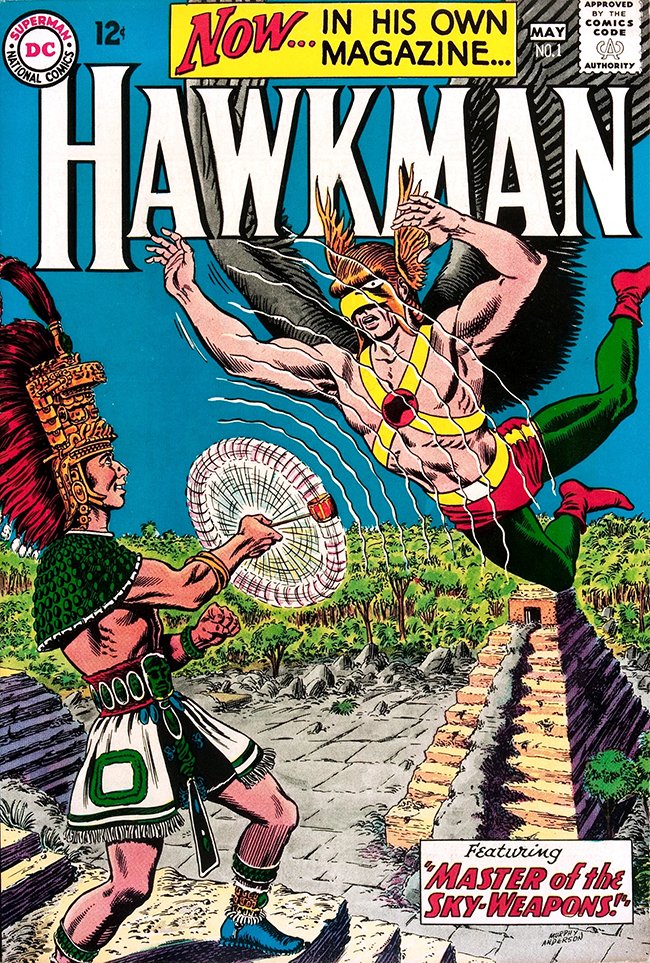
Hawkman during the Silver Age & Bronze Age
Hawkman and Hawkgirl were reintroduced in the DC Universe in The Brave and the Bold #34. After two storylines, one more in Mystery in Space and a few guest appearances, the first Hawkman series was launched. After 27 issues, Hawkman merged with Atom in The Atom and Hawkman #39. The title was canceled anyway after a few issues.
Collected in the DC Finest line (incomplete for now):
- DC Finest: Hawkman – Wings Across Time [2025]
See our Hawkman guide. Collects The Brave And The Bold #34-36, #42-44, Mystery in Space #87-90, The Atom #7 and Hawkman #1-16.
Previously collected in Showcase Presents
- Showcase Presents: Hawkman Vol. 1
Collects The Brave and the Bold #34–36, 42–44, & 51, The Atom #7, Mystery in Space #87–90; Hawkman Vol. 1 #1–11. - Showcase Presents: Hawkman Vol. 2
Collects Hawkman Vol. 1 #12–27, The Atom #31, The Atom and Hawkman #39–45, The Brave and the Bold Vol.1 #70.
Like during the Golden Age, Hawkman was part of a team. This time, it was the Justice League of America (starting with Justice League of America #31 up until #230), and, during that time, he met with Carter Hall at least once a year in the annual Crisis on Multiple Earths crossovers.
For more about that, take a look at our Justice League Reading Order.
Also, in 1973-74, Hawkman (and Hawkwoman) appeared in Detective Comics backup stories, Showcase, and World’s Finest, most of which are not collected.
- Detective Comics (Back-up) #428, 434, 438-439, 442, 446, 452, 454-455, 467-468
- Showcase #101-103
- Detective Comics (Back-up) #479-480, and 500.
- World’s Finest Comics #256-259, 261-262, 264-265
- Detective Comics #500.
- World’s Finest Comics #266-270, 272-277, 279-282
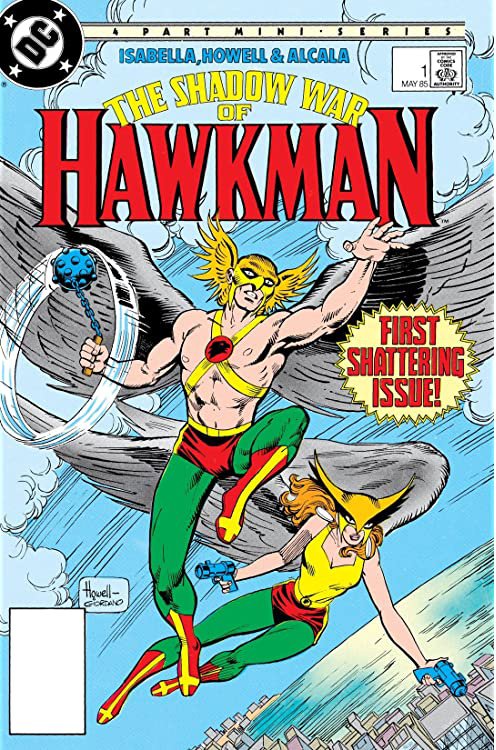
- The Shadow War of Hawkman
Collects The Shadow War of Hawkman #1-4.
![]() In 1985, Crisis on Infinite Earths was the first universe-redefining crossover comic book event ever. The goal was to simplify and unify the DC Universe. The Earth-One/Earth-Two dichotomy was resolved by merging the Multiverse into a single universe. A lot was erased from the continuity. For more information, go to our Crisis on Infinite Earths Reading Order.
In 1985, Crisis on Infinite Earths was the first universe-redefining crossover comic book event ever. The goal was to simplify and unify the DC Universe. The Earth-One/Earth-Two dichotomy was resolved by merging the Multiverse into a single universe. A lot was erased from the continuity. For more information, go to our Crisis on Infinite Earths Reading Order.
- Crisis On Infinite Earths 30th Anniversary Deluxe Edition
Collects Crisis on Infinite Earths #1-12. - The Last Days of the Justice Society of America (one-shot)

Hawkman during the Modern Age
The second series of Hawkman was launched, this time from Tony Isabella and Richard Howell, the team behind The Shadow War of Hawkman miniseries.
- Hawkman (Volume 2)
Collects Hawkman #1-17.
In 1989, a Hawkworld miniseries that updated the origin of the Silver Age Hawkman, Katar Hol. It was a popular book and DC decided to launch after that success a monthly Hawkworld series–by John Ostrander and Tim Truman. That’s when things got a bit confusing. This new ongoing series was set in the present continuity, a creative decision that introduced some contradictions with Hawkman’s post-Crisis appearances so far.
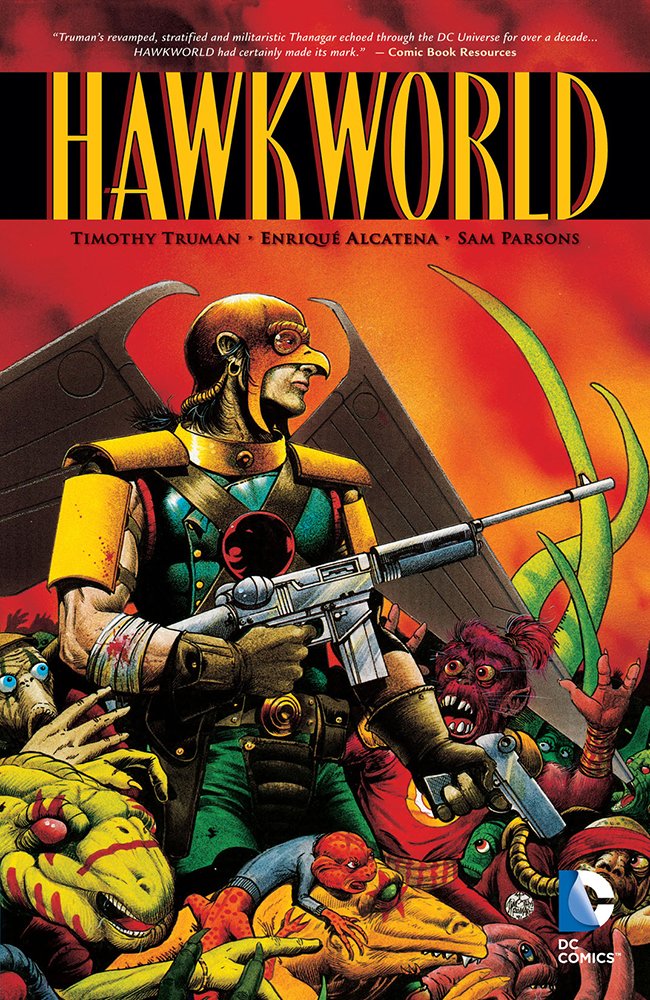
- Hawkworld: New Edition
Collects Hawkworld #1-3 (the miniseries). - Hawkworld
Collects Hawkworld #1-32, Annuals #1-3. - Hawkman (Volume 3)
Collects Hawkman Vol. 3 #1-12, Annuals #1.
![]() And then came the Zero Hour: A Crisis in Time event (see reading order here). All of reality comes under attack when a mysterious force of entropy begins slowly erasing time itself—making its way from both the past and future toward the present!
And then came the Zero Hour: A Crisis in Time event (see reading order here). All of reality comes under attack when a mysterious force of entropy begins slowly erasing time itself—making its way from both the past and future toward the present!
During the Zero Hour event, the different Hawkmen were merged into a “Hawkgod” who became the main character in the second part of the third volume of the ongoing Hawkman series.
- Hawkman (Volume 3)
Collects Hawkman Vol. 3 #13-33, Annuals #2.
Published in 2000, the Legend of the Hawkman miniseries is sort of an out-of-continuity series that takes us back to the Silver Age, soon after Hawkman and Hawkgirl’s arrival on Earth as the duo faces an ancient menace with connections to their Thanagarian heritage.
- Legend of the Hawkman
Collects Legend of the Hawkman #1-3.

After Volume 3 concluded in 1996, Hawkman disappeared for a while. He came back at the beginning of the 2000s with the JSA and a new series written by Geoff Johns.
- Justice Society Returns
Collects All Star Comics vol. 2 #1–2; Adventure Comics vol. 2 #1; All-American Comics vol. 2 #1; National Comics vol. 2 #1; Sensation Comics vol. 2 #1; Smash Comics vol. 2 #1; Star-Spangled Comics vol. 2 #1; Thrilling Comics vol. 2 #1; Golden Age Secret Files #1; JSA Secret Files #1. - JSA, vol. 1: Justice Be Done
Collects JSA #1–5; JSA Secret Files #1.
- Hawkgirl is part of the JSA (see reading order here), and Hawkman is back with JSA #23.
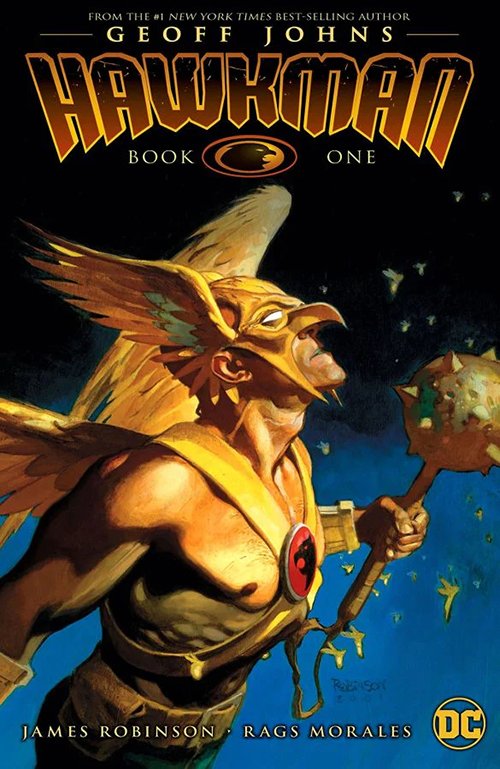
- JSA, vol. 3: The Return of Hawkman
Collects JSA #16–25; JSA Secret Files #1. - Hawkman by Geoff Johns Book One
Hawkman #1-14 and Hawkman: Secret Files and Origins #1. - Hawkman by Geoff Johns Book Two
Collects Hawkman #15-25 and JSA #56-58.- The The Hawkman Omnibus by Geoff Johns (2025 Edition) is collecting Hawkman Vol. 4 #1-25, Hawkman Secret Files #1, JSA #56-58.
- Identity Crisis
Collects Identity Crisis #1-7. More information about the event in our Identity Crisis Reading Order. - Hawkman, vol. 4: Rise of the Golden Eagle
Collects Hawkman #37-45.
![]() A big event with Infinite Crisis. OMAC robots are rampaging, magic is dying, villains are uniting, and a war is raging in space. During this event, some of the surviving Golden Age characters are transported to the new “Earth-Two” created by Alexander Luthor Jr. Go to the Infinite Crisis Reading Order for more information.
A big event with Infinite Crisis. OMAC robots are rampaging, magic is dying, villains are uniting, and a war is raging in space. During this event, some of the surviving Golden Age characters are transported to the new “Earth-Two” created by Alexander Luthor Jr. Go to the Infinite Crisis Reading Order for more information.
- The Rann-Thanagar War
Collects Rann-Thanagar War #1-6 and Rann-Thanagar War: Infinite Crisis Special #1 - Infinite Crisis
Collects Infinite Crisis #1-7. - Hawkman #46-49 are part of the event, but are not collected yet.
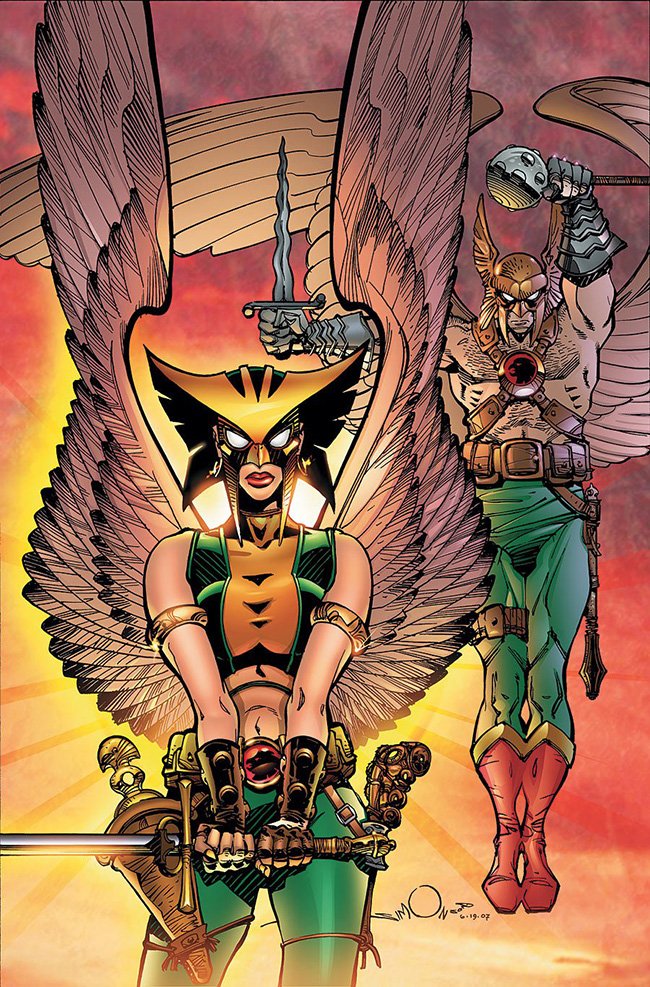
After Hawkman #49, Hawkman is gone and the series was renamed Hawkgirl as Kendra is the main character. Hawkman came back pretty quickly though.
- Hawkgirl: The Maw
Collects Hawkgirl #50-56. - Hawkgirl: Hawkman Returns
Collects Hawkgirl #57-60.- Hawkman is back and immediately joined the new JSA:
- Justice Society of America: The Next Age
Collects Justice Society of America vol. 3 #1-4.
- Hawkgirl: Hath Set
Collects Hawkgirl #61-66.
After Infinite Crisis, Mystery in Space, and 52, the cosmic series continues with the Rann-Thanagar Holy War. Adam Strange, Hawkman, Captain Comet, and more. Can our heroes stop the nefarious Lady Styx from turning the entire universe into her own congregation? It is important to note that, in the Hawkman Special, the being called Demiurge reveals to Carter Hall that his previous existence as Prince Khufu was an illusion. Demiurge calls Hawkman “Katar Hol” in a way suggesting that Hawkman is in fact Katar Hol who believed he was Carter Hall (Just to add e bit more confusion).
- Rann-Thanagar Holy War Vol. 1
Collects Rann-Thanagar Holy War #1-4 and Hawkman Special #1. - Rann-Thanagar Holy War Vol. 2
Collects Rann-Thanagar Holy War #5-8 and Adam Strange Special #1. - Final Crisis
Collects DC Universe #0, Final Crisis #1-7, Final Crisis: Superman Beyond #1-2, Final Crisis: Submit #1, Batman #682-683. For more about the event, take a look at our Final Crisis Reading Order.
Dead or alive? Things get complicated for Hawkman and Hawkgirl during the Blackest Night.
- Blackest Night Saga (DC Essential Edition) or regular edition
Collects Blackest Night #0-8.- Blackest Night: Rise of the Black Lanterns
Collects Power Of Shazam! #48, Catwoman #83, Suicide Squad #67, Question #37, Phantom Stranger #42, Weird Western Tales #71, Atom and Hawkman #46, Starman #81.
- Blackest Night: Rise of the Black Lanterns
![]() After the Blackest Night came Brightest Day. Once dead, twelve heroes and villains–including Hawkman–were resurrected by a white light expelled deep within the center of the earth and must discover the mysterious reason behind their return and uncover the secret that binds them all.
After the Blackest Night came Brightest Day. Once dead, twelve heroes and villains–including Hawkman–were resurrected by a white light expelled deep within the center of the earth and must discover the mysterious reason behind their return and uncover the secret that binds them all.
- Brightest Day Omnibus
Collects Brightest Day #0-24.

Hawkman during the New 52
In 2011, The New 52 rebooted DC’s continuity. Everything starts with Carter Hall not wanting to be Hawkman anymore and realizing that he can’t escape it. Also, as we learned later, this is not Hall, but Katar Hol assuming the identity of Carter Hall…

- The Savage Hawkman Vol. 1: Darkness Rising
Collects The Savage Hawkman #1-8. - The Savage Hawkman Vol. 2: Wanted
Collects The Savage Hawkman #0, #9-20.
Not the biggest era for Hawkman, but he was also in Justice League of America and, after the Trinity War/Forever Evil event, he joined the Justice League United. And out-of-continuity, during the Convergence event, pre-Crisis Hawkman and Hawkgirl came back (collected in Convergence: Crisis Book One).

Hawkman during the Rebirth Era
In 2016, the New 52 era concluded and DC Comics relaunched its entire line under the banner “Rebirth.” Again, it was not a busy period for the Hawks, up until the Dark Nights: Metal event. Before that, the miniseries The Death of Hawkman brings back Kator Hol to kill him (like the title says).
- The Death of Hawkman
Collects Death of Hawkman #1-6.
![]() Dark Nights: Metal is proposing a new ambitious story about the mysterious Nth metal and the dark multiverse. Investigating a strange metal, Batman discovers the existence of a dark multiverse and eventually releases seven evil versions of himself into his own universe. That event is led by Barbatos, the dark god who plans to unleash darkness across every Earth. Stopping him will change the DC Universe forever.
Dark Nights: Metal is proposing a new ambitious story about the mysterious Nth metal and the dark multiverse. Investigating a strange metal, Batman discovers the existence of a dark multiverse and eventually releases seven evil versions of himself into his own universe. That event is led by Barbatos, the dark god who plans to unleash darkness across every Earth. Stopping him will change the DC Universe forever.
The real Carter Hall returns as Hawkman to the DC Universe in Dark Days: The Forge. Got to our Dark Nights: Metal Reading Order to know how to read those books:
- Dark Days: The Road to Metal
Collects Dark Days: The Forge #1 and Dark Days: The Casting #1, as well as classic DC stories that built the foundations of Metal, including Final Crisis #6-7, Batman: The Return of Bruce Wayne #1, Batman #38-39, Nightwing #17 and more. - Dark Nights: Metal
Collects Dark Nights: Metal #1-6, Dark Knights Rising: The Wild Hunt #1, and Batman Lost #1. - Dark Nights: Metal: The Resistance
Collects “Gotham Resistance” (Teen Titans #12, Nightwing #29, Suicide Squad #26, Green Arrow #32) and “Bats Out Of Hell” (The Flash #33, Justice League #32-33, Hal Jordan and The Green Lantern Corps #32), plus Batman Lost #1 and Hawkman Found #1.

After Dark Nights: Metal, a new Hawkman series written by Robert Venditti and illustrated by Bryan Hitch was launched. It quickly dealt with Carter Hall’s multiple lives, offering an explanation to Katar Hol and the others.
- Hawkman: Awakening
Collects Hawkman #1-6. - Hawkman Vol. 2: Deathbringer
Collects Hawkman #7-12. - Hawkman Vol. 3: Darkness Within
Collects Hawkman #13-18. - Hawkman Vol. 4: Hawks Eternal
Collects Hawkman #20-29.
At that point, Dark Nights: Death Metal put an end to the Rebirth era. You can learn more about the event with our dedicated reading order.

Hawkman in the Infinite Frontier era
Despite making his cinematic debut in 2022 in the Black Adam movie, played by Aldis Hodge, the past years haven’t been great for Hawkman. He hasn’t headlined a title and mostly appears in short stories in several DC Holiday specials.
- DC’s Love is a Battlefield
One-shot. The Hawks are present in the story “Together Forever” - Tis the Season to be Freezin’
One-shot. Hawkman appears in the Harley Quinn story “A Change of Heart” - Dark Crisis: Worlds Without a Justice League: Green Lantern #1
One-shot Part of the Dark Crisis event. Contains the Backup story “Dark Crisis: Worlds Without a Justice League – Hawkgirl” - Grifter got run over by a Reindeer
One-shot. Hawkman and Hawkwoman appear in “Home for the Holidays”
Did we forget an important issue? Did we make a mistake? Let us know in the comments!